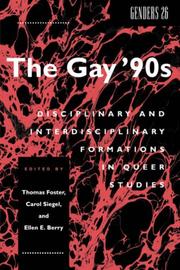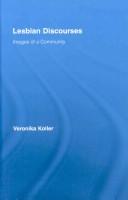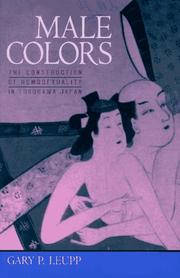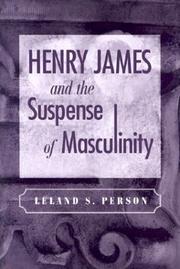| Listing 1 - 6 of 6 |
Sort by
|

ISBN: 0814726739 Year: 1997 Volume: 26 Publisher: New York ; London New York University Press
Abstract | Keywords | Export | Availability | Bookmark
 Loading...
Loading...Choose an application
- Reference Manager
- EndNote
- RefWorks (Direct export to RefWorks)
Etudes homosexuelles et lesbiennes --- Gay and lesbian studies --- Gay men--Study and teaching --- Gay studies --- Gays--Study and teaching --- Homophile studies --- Homoseksualiteit en literatuur --- Homoseksualiteit in de literatuur --- Homoseksuele en lesbische studies --- Homosexuality [Male ]--Study and teaching --- Homosexuality and literature --- Homosexuality in literature --- Homosexuality--Study and teaching --- Homosexualité dans la littérature --- Homosexualité et littérature --- Lesbian and gay studies --- Lesbian studies --- Lesbianism--Study and teaching --- Lesbians--Study and teaching

ISBN: 9780415960953 0415960959 9780203928691 9781135900458 9781135900496 9781135900502 9780415883894 Year: 2008 Volume: 9 Publisher: New York London Routledge
Abstract | Keywords | Export | Availability | Bookmark
 Loading...
Loading...Choose an application
- Reference Manager
- EndNote
- RefWorks (Direct export to RefWorks)
#KVHA:Taalkunde --- #KVHA:Discourse analysis --- #KVHA:Gender --- #KVHA:Lesbian discourse --- #KVHA:Homosexualiteit --- Feminisme en lesbianisme --- Lesbianisme --- discoursanalyse --- discourse analysis --- taalgebruik --- Feminisme en lesbianisme. --- discoursanalyse. --- discourse analysis. --- taalgebruik. --- Gay and lesbian studies --- Lesbian feminist theory --- Lesbianism --- Female homosexuality --- Lesbian love --- Sapphism --- Homosexuality --- Women --- Lesbian feminism --- Lesbian feminist sociology --- Theory of lesbian feminism --- Feminist theory --- Gay studies --- Homophile studies --- Lesbian and gay studies --- Lesbian studies --- Education --- Sexual behavior --- Philosophy --- Curricula
Book
ISBN: 9780812245370 0812245377 1322512663 0812208587 Year: 2013 Volume: *72 Publisher: Philadelphia University of Pennsylvania Press
Abstract | Keywords | Export | Availability | Bookmark
 Loading...
Loading...Choose an application
- Reference Manager
- EndNote
- RefWorks (Direct export to RefWorks)
In his Problemata, Aristotle provided medieval thinkers with the occasion to inquire into the natural causes of the sexual desires of men to act upon or be acted upon by other men, thus bringing human sexuality into the purview of natural philosophers, whose aim it was to explain the causes of objects and events in nature. With this philosophical justification, some late medieval intellectuals asked whether such dispositions might arise from anatomy or from the psychological processes of habit formation. As the fourteenth-century philosopher Walter Burley observed, "Nothing natural is shameful." The authors, scribes, and readers willing to "contemplate base things" never argued that they were not vile, but most did share the conviction that they could be explained. From the evidence that has survived in manuscripts of and related to the Problemata, two narratives emerge: a chronicle of the earnest attempts of medieval medical theorists and natural philosophers to understand the cause of homosexual desires and pleasures in terms of natural processes, and an ongoing debate as to whether the sciences were equipped or permitted to deal with such subjects at all. Mining hundreds of texts and deciphering commentaries, indices, abbreviations, and marginalia, Joan Cadden shows how European scholars deployed a standard set of philosophical tools and a variety of rhetorical strategies to produce scientific approaches to sodomy.
Sociology of knowledge --- Sexology --- History of Europe --- anno 500-1499 --- Sodomy --- Male homosexuality --- Science, Medieval --- Philosophy, Medieval --- History --- Medieval philosophy --- Scholasticism --- Medieval science --- Homosexuality, Male --- Homosexuality --- Men --- Buggery --- Pederasty --- Sex crimes --- Sexual behavior --- Gay Studies. --- Gender Studies. --- History. --- Lesbian Studies. --- Medieval and Renaissance Studies. --- Queer Studies.
Book
ISBN: 0873525639 Year: 1995 Publisher: New York Modern Language Association of America
Abstract | Keywords | Export | Availability | Bookmark
 Loading...
Loading...Choose an application
- Reference Manager
- EndNote
- RefWorks (Direct export to RefWorks)
Canon (Literature) --- Canon (Literatuur) --- Canons littéraires --- Etudes homosexuelles et lesbiennes --- Gay and lesbian studies --- Gay men in literature --- Gay men--Study and teaching --- Gay studies --- Gays--Study and teaching --- Hommes homosexuels dans la littérature --- Homophile studies --- Homoseksualiteit en literatuur --- Homoseksuele en lesbische studies --- Homoseksuele mannen in de literatuur --- Homosexuality [Male ]--Study and teaching --- Homosexuality and literature --- Homosexuality--Study and teaching --- Homosexualité et littérature --- Lesbian and gay studies --- Lesbian studies --- Lesbianism--Study and teaching --- Lesbians in literature --- Lesbians--Study and teaching --- Lesbiennes dans la littérature --- Lesbiennes in de literatuur --- Literaire canon --- American literature --- English literature --- Gay and lesbian studies. --- Gay men in literature. --- Gays --- Gays' writings --- Gays' writings, American --- Gays' writings, English --- Lesbians in literature. --- Study and teaching. --- Intellectual life. --- History and criticism --- Theory, etc. --- Canon (Literature). --- Gays' writings [American ] --- Study and teaching --- Gays' writings [English ] --- Intellectual life

ISBN: 052091919X 0585106037 9780520919198 9780585106038 0520086279 Year: 1995 Publisher: Berkeley ; Los Angeles ; London University of California Press
Abstract | Keywords | Export | Availability | Bookmark
 Loading...
Loading...Choose an application
- Reference Manager
- EndNote
- RefWorks (Direct export to RefWorks)
Tokugawa Japan ranks with ancient Athens as a society that not only tolerated, but celebrated, male homosexual behavior. Few scholars have seriously studied the subject, and until now none have satisfactorily explained the origins of the tradition or elucidated how its conventions reflected class structure and gender roles. Gary P. Leupp fills the gap with a dynamic examination of the origins and nature of the tradition. Based on a wealth of literary and historical documentation, this study places Tokugawa homosexuality in a global context, exploring its implications for contemporary debates on the historical construction of sexual desire. Combing through popular fiction, law codes, religious works, medical treatises, biographical material, and artistic treatments, Leupp traces the origins of pre-Tokugawa homosexual traditions among monks and samurai, then describes the emergence of homosexual practices among commoners in Tokugawa cities. He argues that it was "nurture" rather than "nature" that accounted for such conspicuous male/male sexuality and that bisexuality was more prevalent than homosexuality. Detailed, thorough, and very readable, this study is the first in English or Japanese to address so comprehensively one of the most complex and intriguing aspects of Japanese history.
Male homosexuality --- Gender & Ethnic Studies --- Social Sciences --- Gay & Lesbian Studies --- Homosexuality, Male --- Homosexuality --- Men --- History. --- History --- Sexual behavior --- Japan --- Social life and customs. --- Nanshoku. --- Homosexualité masculine --- Social life and customs --- Tokugawa period, 1600-1868 --- Nanshoku --- Male homosexuality. --- academic. --- artistic treatments. --- asia. --- asian history. --- biographical material. --- bisexuality. --- class structure. --- commoners. --- cultural history. --- early modern jaan. --- gay studies. --- gay. --- gender roles. --- global context. --- historical documentation. --- homosexual traditions. --- japanese history. --- law codes. --- lgbt history. --- literary documentation. --- male homosexual behavior. --- medical treatises. --- monks. --- politics. --- popular fiction. --- queer history. --- religious works. --- samurai. --- sexual desire. --- sexual expression. --- sexual relations. --- sexuality. --- tokugawa bakufu. --- tokugawa japan.

ISBN: 0812237250 1322510970 0812203232 Year: 2003 Publisher: Philadelphia University of Pennsylvania Press
Abstract | Keywords | Export | Availability | Bookmark
 Loading...
Loading...Choose an application
- Reference Manager
- EndNote
- RefWorks (Direct export to RefWorks)
Using insights from feminist studies, men's studies, and gay and queer studies, Leland Person examines Henry James's subversion of male identity and the challenges he poses to conventional constructs of heterosexual masculinity. Sexual and gender categories proliferated in the nineteenth and early twentieth centuries, and Person argues that James exploited the taxonomic confusion of the times to experiment with alternative sexual and gender identities. In contrast to scholars who have tried to give a single label to James's sexuality, Person argues that establishing James's gender and sexual identity is less important than examining the novelist's shaping of male characters and his richly metaphorical language as an experiment in gender and sexual theorizing. Just as an author's creations can be animated by his or her own sexuality, Person contends, James's sexuality may be most usefully understood as something primarily aesthetic and textual. As Person shows in chapters devoted to some of this author's best-known novels-Roderick Hudson, The American, The Portrait of a Lady, The Bostonians, The Ambassadors, The Golden Bowl-James conducts a series of experiments in gender/sexual construction and deconstruction. He delights in positioning his male characters so that their gender and sexual orientations are reversed, ambiguous, and even multiple. Ultimately, he keeps male identity in suspense by pluralizing male subjectivity.
Psychological study of literature --- James, Henry --- Hommes dans la littérature --- Mannelijkheid in de literatuur --- Mannen in de literatuur --- Masculinity in literature --- Masculinité dans la littérature --- Men in literature --- Rôle selon le sexe dans la littérature --- Seksualiteit in de literatuur --- Seksuele rolpatronen in de literatuur --- Sex in literature --- Sex role in literature --- Sexe dans la littérature --- Homosexuality and literature --- Masculinity in literature. --- Men in literature. --- Psychological fiction, American --- Sex in literature. --- Sex role in literature. --- History and criticism. --- Characters --- Men --- Knowledge --- Psychology --- Psychological fiction [American ] --- History and criticism --- United States --- James, Henry, --- Men. --- Psychology. --- Masculinity (Psychology) in literature --- Dzheĭms, G. --- Dzheĭms, Genri, --- Jeimsŭ, Henri, --- Джеймс, Генри, --- ג׳יימס, הנרי, --- ג׳ײמס, הנרי, --- Τζειος, Χενρι, --- جميس، هينري، --- جيمز، هنرى --- Homosexualitat i literatura --- Homes en la literatura --- Novel·la psicològica anglesa --- Masculinitat en la literatura --- Rol sexual en la literatura --- Història i crítica --- Personatges --- Homes --- Coneixements --- Psicologia --- Novel·la anglesa --- Literatura i homosexualitat --- Literatura --- James, --- Dzheims, G., --- Dzheims, Genri, --- Jeimsu, Henri, --- Cultural Studies. --- Gay Studies. --- Gender Studies. --- Lesbian Studies. --- Literature. --- Queer Studies.
| Listing 1 - 6 of 6 |
Sort by
|

 Search
Search Feedback
Feedback About UniCat
About UniCat  Help
Help News
News